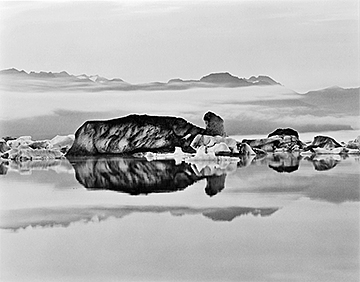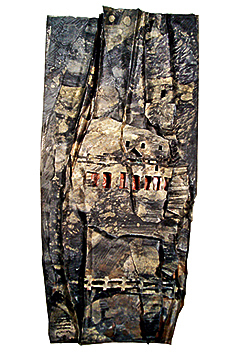
|
|
Vol. LXIII, No. 10
|
|
Wednesday, March 11, 2009
|
 |
 |
|
IMAGINING ICELAND: The subject of Paula Chamlee’s platinum print, “Jökulsárlón # 35,” is said to be the best known and the largest of a number of glacial lakes in Iceland. Her photographs and short film, “Flow,” will be at the James A. Michener Museum through March 1 in “Shifting Ground: Contemporary Landscapes by Paula Chamlee, Alan Goldstein, and Paul Matthews.” A members’ reception is being held on Friday, January 16 from 6 to 7:30 p.m.
|
SLEEPING BUDDHA CAVE: Anne Elliott’s rice-paper sculpture was inspired by her 2006 visit to China’s Mogao Caves, which, according to her statement, “contain thousands of Buddhist frescoes and statues,” as well as “seemingly endless stone steps and paths that wind through rock, crag, and mist.” “Immortal Mountains Hallowed Caves” can be seen at the Silva Gallery in the Pennington School Campus Center from now through February 7. The artist is a graphic designer at Town Topics.
|
“It turned me into a sculptor,” says Anne Elliott, who in addition to trekking to the base camp on K2, the world’s second-highest mountain, has climbed 25 others. “The experience of total wilderness, of being where the creation of the Earth is still visibly in progress so transformed my work that I found two-dimensional forms no longer adequate.” So what does she do? She makes her own rice-paper caves and mountains.
Paula Chamlee switched from painting to photography when she, too, felt the irresistible pull of the world outside the studio. According to the website she shares with her photographer husband, Michael A. Smith (www.paulaandmichael.com), “The act of photographing” intensifies her “seeing and sense of being in the world.” Like Elliott, she feels a “personal” relationship to landscape, and the moment of contact is one in which she feels “a deep and exciting ‘yes.’”
Recent visits to China and Iceland have provided these two artists with material for compelling new exhibits within easy trekking distance of Princeton. Anne Elliott’s “Immortal Mountains Hallowed Caves,” inspired by a 2006 visit to the Mogao Caves at Dunhuang and Huangshan (Yellow Mountain) in China, can be seen at the Silva Gallery in the Pennington School Campus Center, while Paula Chamlee’s Icelandic visions form an oasis at the heart of “Shifting Ground,” an exhibition at the James A. Michener Art Museum in Doylestown featuring her work, along with that of Alan Goldstein and Paul Matthews.
Will and Imagination
Writing in Arts magazine in March 1978 about the prevailing notion that landscape was the “province of the painter,” critic Harvey Stahl suggested that “landscapists” attempting to create “pictorial equivalents” for “sculptural effects … of nature” were necessarily confined to the “illusionistic and two-dimensional” surface. He found that Anne Elliott, on the other hand, had “especially sought out” exactly that “sculpturally rich” aspect of nature. As can be seen on her website (www.anne-elliott.com), most of her earlier work in the three-dimensional medium she was the first to make sculptural use of is on the grand scale. Painting sheets of rice paper to suggest rock surfaces and sewing some together to make immense ribbons of paper that she then reinforced with cheesecloth and matte varnish, she created an alternative to clay that was at once stiff and flexible. With this material, she could compose in relief on walls or in space by using monofilament to attach the pieces to a ceiling grid. “The surprise of the work,” according to former New York Times art critic Hilton Kramer, “comes from the success with which a medium so lightweight and malleable captures the feeling of a theme so weighty and awesome and earthbound.”
The show’s centerpiece, Yellow Mountain, is the only work that dwarfs the viewer the way her earlier sculptures did; the seductive creations inspired by her experience with the caves and mountains of China actually benefit from the smaller, more focused, more intimate scale. There are winding steps to ascend and descend, rickety bridges to cross, folds and creases to slide through, and windows to peer into, each variously sized and shaped vision as if torn from the same “sculpturally rich” landscape cited by Harvey Stahl. It’s exciting to see a mature artist picking up where she left off a quarter century ago, contending with, rediscovering, and reimagining the medium of her first adventure in art.
Flowing
When she went to Iceland in the summer of 2004 (and again in 2006), Paula Chamlee looked forward to “great adventure and visual discovery.” What the photographer found was the “swirling, flowing movement in lava, earth, and ice” that she has converted into a self-contained element in the “Shifting Ground” exhibit. There you can sit in front of three connected screens surrounded by purely abstract black and white platinum prints of Icelandic vistas (visions more than vistas, really) while watching Flow, a 13-minute two-part film Chamlee made in Iceland in the summer of 2006. Besides putting into visual play what the artist calls “the universal rhythm — that common movement of all living things,” the film encourages an awareness of the incessant flow of the present in a way that images frozen in time cannot. As you watch the filmed movement of water, contemplating and all but feeling the soft rain that sets the surface rippling while tides form and recede and birds flit from screen to screen, you find yourself experiencing a semblance of what D.H. Lawrence meant by “the poetry of the present,” where there is “no perfection, no consummation, nothing finished,” where “the strands are all flying, quivering, intermingling,” where “the whole tide of all time and all life suddenly heaves,” and where we see “the very substance of creative change.” The sense of change is heightened by the way the images pass from one to another of the screens, in a wordless, abstract, three-part narrative on the theme of flowing. It’s a silent movie in two parts, Part One all silent, Part Two with subtle mood music in the form of a recorded piano accompaniment that complements the movement while adding a wistful human dimension to the subhuman world the photographer terms a “wild and otherworldly landscape.”
Empty Rooms, Full House
Because the Wachovia gallery was empty the whole time I was there, the repeated playing of the film and its sad and searching music made the emptiness thematic, particularly when I ventured into the adjacent exhibits. The flow of sounds and images presumably continues all the hours the museum is open, with or without an audience. When you think of art as something removed from human view and response, as if abandoned to the forces of time and weather, those incredible Icelandic landscapes begin to make scary sense. It’s nice to have a museum to yourself, but it’s not at all cheering to feel that this is the fate of art when it goes up against nature, whether the human instrument is Ansel Adams or Richard Serra, Paula Chamlee or Anne Elliott.
A few days after my visit to the empty gallery, I found the other extreme at the opening night reception for “Immortal Mountains Hallowed Caves.” The Silva, an excellent venue, was packed, the scene was lively, and there was a buffet in the adjoining room. Your perceptual equilibrium is bound to take a hit when the sound level is super charged and people on all sides are expressing their opinions about the works on the wall. I was admiring one piece, possibly the smallest in the show, a gem, when I heard someone say, in effect, “I’ll take it,” and it was sold — art appreciation in action! At the Michener, where I had the place to myself, I could almost see the silence and desolation of the room reflected in the ghostly canyons of vistas like Djupaviic and even more in Jökulsárlón #35, which already had the sinister, surreal quality of a secret harbor (it’s no surprise to learn that scenes from James Bond films were shot there, not to mention sequences from Beowulf and Grendel, Tomb Raider, Die Another Day, and Batman Begins).
While the flat surfaces of Paula Chamlee’s Icelandic abstractions seem to discourage any imagined human interaction, film crews notwithstanding, Anne Eliott’s three-dimensional constructions show evidence of human inhabitants, “shrines cut by sculptors into the living rock.” According to the artist’s statement: “They contain thousands of Buddhist frescoes and statues, the product of a millennium of devotion and inspiration.” Even with the roar of conversation in a crowded gallery, the raw force of Elliott’s “hallowed” topography comes through. At the same time, there’s a hushed serene quality in the poetry of these caves and mountains that recalls the scene W.B. Yeats delights to imagine in “Lapis Lazuli” where “Every discoloration of the stone,/Every accidental crack or dent,/Seems a water-course or an avalanche,/Or lofty slope where it still snows/Though doubtless plum or cherry-branch/Sweetens the little half-way house/Those Chinamen climb towards.” You may not actually be able to see the Chinamen in Elliott’s work, but with a little concentration and some help from Yeats, they seem to be seated “There on the mountain and the sky.”